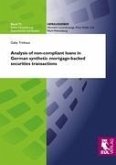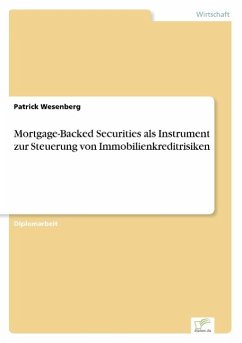Diploma Thesis from the year 2004 in the subject Business economics - Investment and Finance, grade: 1,7, European Business School - International University Schloß Reichartshausen Oestrich-Winkel (Betriebswirtschaftslehre), language: English, abstract: Inhaltsangabe:Abstract:
The securitisation of loans, backed by mortgage liens, has an impressive tradition. The technique was established 234 years ago, in line with the development of the German Pfandbrief . Compared to Germany, the US market has dealt with the securitisation of mortgage loans and the issuance of Mortgage-Backed Securities (MBS) since the 1970 s. Based on the success of MBS, non-mortgage assets were used for securitisation purposes, resulting in a market for Asset-Backed Securities (ABS).
In 2003, the US market issued a total volume of 494 $ billion Asset-Backed Securities, whereas the amount of European issuances increased from 80 billion in 2000 to approximately 190 billion in 2003. Today, the US securitisation market accounts for 80% of the global ABS market, whereas Europe has a global market share of 10%. Within the European market, the United Kingdom is the biggest player, generating a market share of 41%. Germany, as being the largest European provider of corporate, retail and building loans, remains with a global market share of 1% and a European market share of 3%, far below its possibilities. Even though the underlying survey shows that 71% of the interviewed companies believe in a subordinated role of Commercial Mortgage-Backed Securities (CMBS) , the relevance of MBS for the European market is underlined by a differentiation of ABS asset classes. MBS, divided into Residential Mortgage-Backed Securities (RMBS), with a market share of 59%, and Commercial Mortgage-Backed Securities, with a market share of 6%, constitute the most important ABS type.
In Germany, an analysis of the potential for true sale securitisations is reasonable. Only one quarter (237 billion) of all German mortgage loan portfolios is funded through the utilisation of Pfandbriefe. As a consequence the volume for securitisations amounts to approximately 750 billion. Additionally, mortgage banks have funded 61% of their portfolios by issuing Pfandbriefe, whereas the remaining was generated through uncovered instruments. As a result, they will be increased engagements in MBS and CMBS transactions.
Currently, however, the financial sector and especially credit institutions reside in a reorientation phase. Eminently exposed to a highly competitive market, with increasing costs and declining margins, is the credit business. Here, a major problem occurs. During the past decades, credit institutions were engaged in a low margin-competition regarding credit volumes. Thereby, the relation between an adequate credit pricing and the debtors solvency was neglected. As a consequence, credit institutions are today highly overbanked. In addition, commercial financing provided no or less profit, resulting in weak profitability and low Return on Equity (RoE) ratios. To solve the underlying problem, German banks are forced to enhance their income situation. Additionally, banks are affected by a further development. The changing treatment of regulatory capital, with regards to the new Basel Capital Accord (Basel II), will result in radical structural adjustments. Today, credit institutions are obligated to pledge loans with 8% regulatory capital. Additionally, the total amount of loans must not breach 12.5-times of the available equity. As a consequence, up to 90% of the institutions equity is restrained for credit redemption agreements. The situation will, however, change. The amount of regulatory capital will then be calculated on the basis of effective credit risks. Considering this, equity becomes a business restricting as well as a tight resource. In addition to credit institutions, companies that require traditional credit financing ar...
Hinweis: Dieser Artikel kann nur an eine deutsche Lieferadresse ausgeliefert werden.
The securitisation of loans, backed by mortgage liens, has an impressive tradition. The technique was established 234 years ago, in line with the development of the German Pfandbrief . Compared to Germany, the US market has dealt with the securitisation of mortgage loans and the issuance of Mortgage-Backed Securities (MBS) since the 1970 s. Based on the success of MBS, non-mortgage assets were used for securitisation purposes, resulting in a market for Asset-Backed Securities (ABS).
In 2003, the US market issued a total volume of 494 $ billion Asset-Backed Securities, whereas the amount of European issuances increased from 80 billion in 2000 to approximately 190 billion in 2003. Today, the US securitisation market accounts for 80% of the global ABS market, whereas Europe has a global market share of 10%. Within the European market, the United Kingdom is the biggest player, generating a market share of 41%. Germany, as being the largest European provider of corporate, retail and building loans, remains with a global market share of 1% and a European market share of 3%, far below its possibilities. Even though the underlying survey shows that 71% of the interviewed companies believe in a subordinated role of Commercial Mortgage-Backed Securities (CMBS) , the relevance of MBS for the European market is underlined by a differentiation of ABS asset classes. MBS, divided into Residential Mortgage-Backed Securities (RMBS), with a market share of 59%, and Commercial Mortgage-Backed Securities, with a market share of 6%, constitute the most important ABS type.
In Germany, an analysis of the potential for true sale securitisations is reasonable. Only one quarter (237 billion) of all German mortgage loan portfolios is funded through the utilisation of Pfandbriefe. As a consequence the volume for securitisations amounts to approximately 750 billion. Additionally, mortgage banks have funded 61% of their portfolios by issuing Pfandbriefe, whereas the remaining was generated through uncovered instruments. As a result, they will be increased engagements in MBS and CMBS transactions.
Currently, however, the financial sector and especially credit institutions reside in a reorientation phase. Eminently exposed to a highly competitive market, with increasing costs and declining margins, is the credit business. Here, a major problem occurs. During the past decades, credit institutions were engaged in a low margin-competition regarding credit volumes. Thereby, the relation between an adequate credit pricing and the debtors solvency was neglected. As a consequence, credit institutions are today highly overbanked. In addition, commercial financing provided no or less profit, resulting in weak profitability and low Return on Equity (RoE) ratios. To solve the underlying problem, German banks are forced to enhance their income situation. Additionally, banks are affected by a further development. The changing treatment of regulatory capital, with regards to the new Basel Capital Accord (Basel II), will result in radical structural adjustments. Today, credit institutions are obligated to pledge loans with 8% regulatory capital. Additionally, the total amount of loans must not breach 12.5-times of the available equity. As a consequence, up to 90% of the institutions equity is restrained for credit redemption agreements. The situation will, however, change. The amount of regulatory capital will then be calculated on the basis of effective credit risks. Considering this, equity becomes a business restricting as well as a tight resource. In addition to credit institutions, companies that require traditional credit financing ar...
Hinweis: Dieser Artikel kann nur an eine deutsche Lieferadresse ausgeliefert werden.








